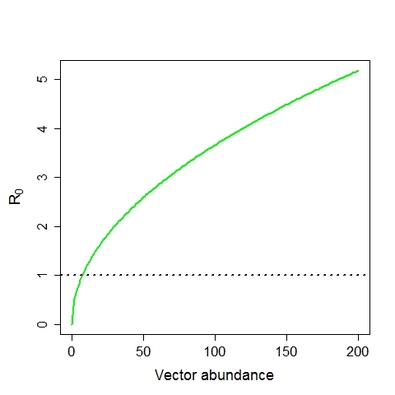For many vector-borne diseases, land managers and policy-makers —including farmers, ranchers, wildlife conservation officials, and public health officials—aim to reduce pathogen spread by suppressing vector populations. And a straight-forward method of vector control is insecticide use. Globally, the World Health Organization estimates that over 6,248 metric tons of insecticides are applied every year to control vectors of human diseases1; this does not include vector control for diseases of plants, livestock, and wildlife. The simple hope here is that lower vector populations will reduce the spread of disease. It’s an intuitive and compelling idea—fewer mosquitoes cause less malaria. But how good are insecticides at reducing disease? Both theory and empirical evidence suggest that the record for insecticides are mixed.
The reasons for this mixed success are (perhaps unsurprisingly) complicated. First, epidemiological theory—in the form of mathematical models that simulate disease spread—predicts that the relationship between vector population size and disease spread is not linear. In such models, we can estimate the rate of disease spread by the term R0 . Called the pathogen reproduction number, the value of R0 represents the number of new infections that the average infected host will cause: if R0 is greater than 1, then each infected host will infect 1 or more new hosts and the pathogen will spread very quickly (exponentially). But the pathogen will not spread when R0 is less than 1, because each infected host fails to infect more than 1 new host. In these cases, the pathogen will die out. If we plot R0 vs. vector population size in a standard epidemic model, we see that, while R0 gets smaller as vector abundance decreases, the vector population has to become very small before the value of R0 goes below the threshold of 1 and the epidemic dies out. So theory predicts that it can be difficult to stop a disease purely by reducing the abundance of vectors, whether by insecticide or other means.
These predictions from theory are also backed up by studies of on-going disease problems. Tom Perring and colleagues from UC Riverside reviewed the evidence on whether insecticides were effective at reducing the spread of plant viruses. They found that in 29% of cases, insecticides were ineffective at reducing pathogen spread 2 . Which cases were successful and which were not depended heavily on the biological interactions between the insect vector and its associated virus—insecticides tended to be successful when insects had to feed on a plant for a long time to acquire the virus and to then infect a new plant (so called “persistently transmitted” viruses), whereas it was hard to control plant viruses that could be picked up and transmitted by insects quickly (“non-persistent” viruses). What’s more, insecticides aren’t always effective at even suppressing vector populations. The mosquito species that transmit the Dengue fever virus are much more difficult to manage with insecticides alone 3 . Rather, an integrated approach is best—incorporating multiple strategies such as removal of stagnant water and distribution of bed nets, in addition to insecticides.
In the late 1990s, new outbreaks of Pierce’s disease devastated many grape vineyards in southern California. These new outbreaks were caused by a new vector, the glassy-winged sharpshooter (Homalodisca vitripennis). In response, state agriculture officials implemented an area-wide management program aimed at reducing populations of the vector, primarily through coordinated insecticide applications in citrus trees—one of the vector’s favorite host plants4. This program has successfully reduced populations of vectors as well as spread of Pierce’s disease in vineyards.
At the same time, vineyard managers have also been spraying insecticides in their vineyards. A recent analysis led by Matt Daugherty at UC Riverside (and with help from Sarah O’Neill, Frank Byrne, and myself), showed that these within-vineyard insecticide applications had little benefit for reducing disease 5. We think this is because most new infections of grape plants occur when glassy-winged sharpshooters disperse from citrus groves to nearby vineyards. Thus the window of opportunity for managers to kill the insects once they’ve arrived in the vineyard, but before they’ve infected a grape plant, is quite narrow.
Clearly, insecticide use for disease management is, in some cases, grossly ineffective. Importantly, any insecticide use should always be balanced with the cost of treatment, the damage they can do to beneficial insects, and the risks to human health. For example, DDT use against malaria mosquitoes remains widespread throughout much of Africa, and it’s unclear if the benefits of DDT use for public health outweigh the harms1,6. (On a tangential note, I highly recommend this blog post on DDT, GM foods, and the scientific difficulty in determining if something is safe or harmful.) The good news is that we can understand which vector-borne diseases are likely to be effectively managed with insecticides and which may require alternative approaches by understanding the ecology of the system—the particular interactions of a pathogen, its vector, and the host.
1. van den Berg, H. et al. Global trends in the use of insecticides to control vector-borne diseases. Environ. Health Perspect. 120, 577–582 (2012).
2. Perring, T. M., Gruenhagen, N. M. & Farrar, C. A. Management of plant viral diseases through chemical control of insect vectors. Annual Review of Entomology 44, 457–481 (1999).
3. Erlanger, T. E., Keiser, J. & Utzinger, J. Effect of dengue vector control interventions on entomological parameters in developing countries: a systematic review and meta-analysis. Medical and Veterinary Entomology 22, 203–221 (2008).
4. Toscano, N. C., Gispert, C., Snyder, J. & Mulherin, R. Riverside County glassy-winged sharpshooter area-wide management program in the Coachella and Temecula Valleys. in Proceedings of the Pierce’s Disease Research Symposium 7–10 (2004).
5. Daugherty, M. P., O’Neill, S., Byrne, F. & Zeilinger, A. Is vector control sufficient to limit pathogen spread in vineyards? Environmental Entomology (2015).
6. Curtis, C. F. & Lines, J. D. Should DDT be Banned by International Treaty? Parasitology Today 16, 119–121 (2000).


 RSS Feed
RSS Feed
